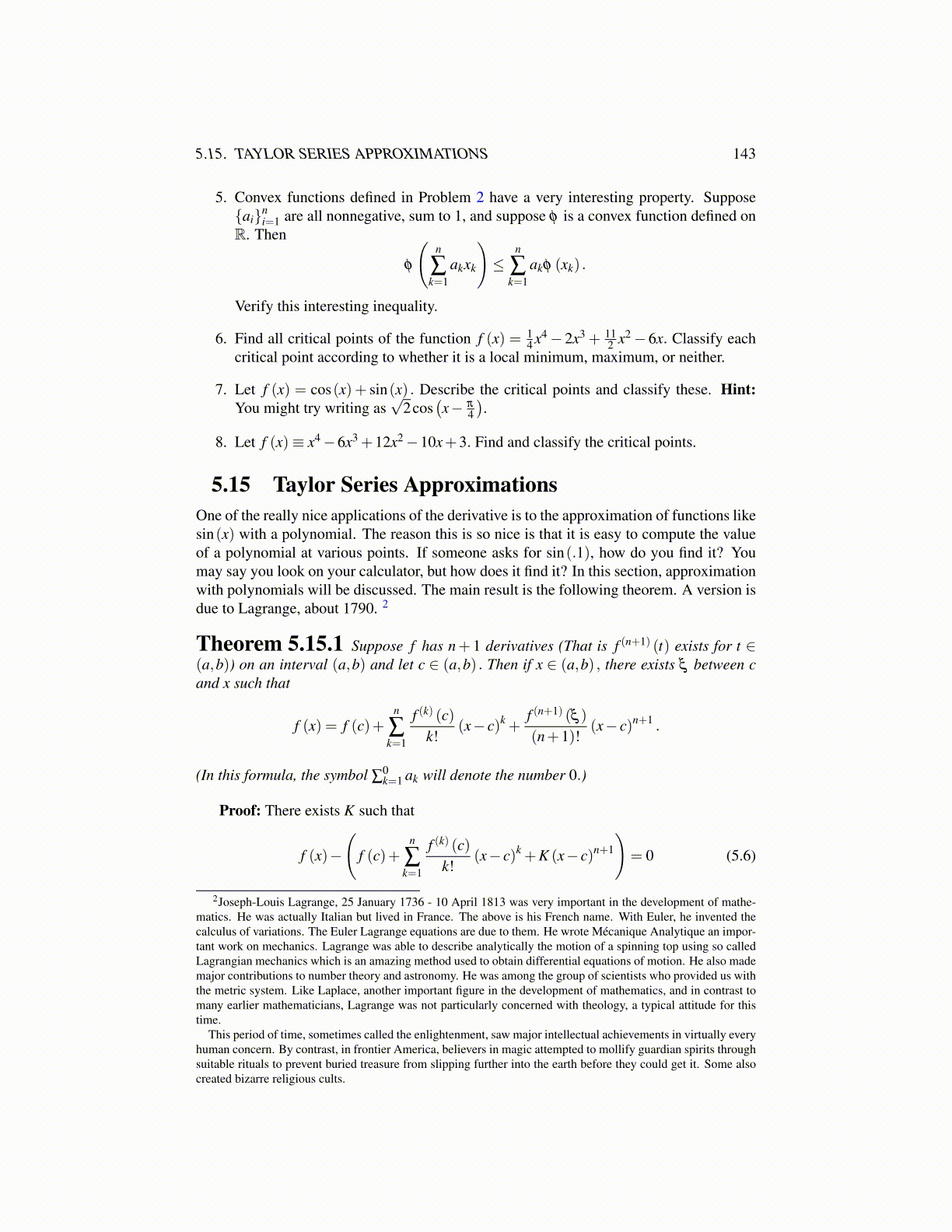
5.15. TAYLOR SERIES APPROXIMATIONS 143
5. Convex functions defined in Problem 2 have a very interesting property. Suppose{ai}n
i=1 are all nonnegative, sum to 1, and suppose φ is a convex function defined onR. Then
φ
(n
∑k=1
akxk
)≤
n
∑k=1
akφ (xk) .
Verify this interesting inequality.
6. Find all critical points of the function f (x) = 14 x4 − 2x3 + 11
2 x2 − 6x. Classify eachcritical point according to whether it is a local minimum, maximum, or neither.
7. Let f (x) = cos(x)+ sin(x) . Describe the critical points and classify these. Hint:You might try writing as
√2cos
(x− π
4
).
8. Let f (x)≡ x4 −6x3 +12x2 −10x+3. Find and classify the critical points.
5.15 Taylor Series ApproximationsOne of the really nice applications of the derivative is to the approximation of functions likesin(x) with a polynomial. The reason this is so nice is that it is easy to compute the valueof a polynomial at various points. If someone asks for sin(.1), how do you find it? Youmay say you look on your calculator, but how does it find it? In this section, approximationwith polynomials will be discussed. The main result is the following theorem. A version isdue to Lagrange, about 1790. 2
Theorem 5.15.1 Suppose f has n+ 1 derivatives (That is f (n+1) (t) exists for t ∈(a,b)) on an interval (a,b) and let c ∈ (a,b) . Then if x ∈ (a,b) , there exists ξ between cand x such that
f (x) = f (c)+n
∑k=1
f (k) (c)k!
(x− c)k +f (n+1) (ξ )
(n+1)!(x− c)n+1 .
(In this formula, the symbol ∑0k=1 ak will denote the number 0.)
Proof: There exists K such that
f (x)−
(f (c)+
n
∑k=1
f (k) (c)k!
(x− c)k +K (x− c)n+1
)= 0 (5.6)
2Joseph-Louis Lagrange, 25 January 1736 - 10 April 1813 was very important in the development of mathe-matics. He was actually Italian but lived in France. The above is his French name. With Euler, he invented thecalculus of variations. The Euler Lagrange equations are due to them. He wrote Mécanique Analytique an impor-tant work on mechanics. Lagrange was able to describe analytically the motion of a spinning top using so calledLagrangian mechanics which is an amazing method used to obtain differential equations of motion. He also mademajor contributions to number theory and astronomy. He was among the group of scientists who provided us withthe metric system. Like Laplace, another important figure in the development of mathematics, and in contrast tomany earlier mathematicians, Lagrange was not particularly concerned with theology, a typical attitude for thistime.
This period of time, sometimes called the enlightenment, saw major intellectual achievements in virtually everyhuman concern. By contrast, in frontier America, believers in magic attempted to mollify guardian spirits throughsuitable rituals to prevent buried treasure from slipping further into the earth before they could get it. Some alsocreated bizarre religious cults.